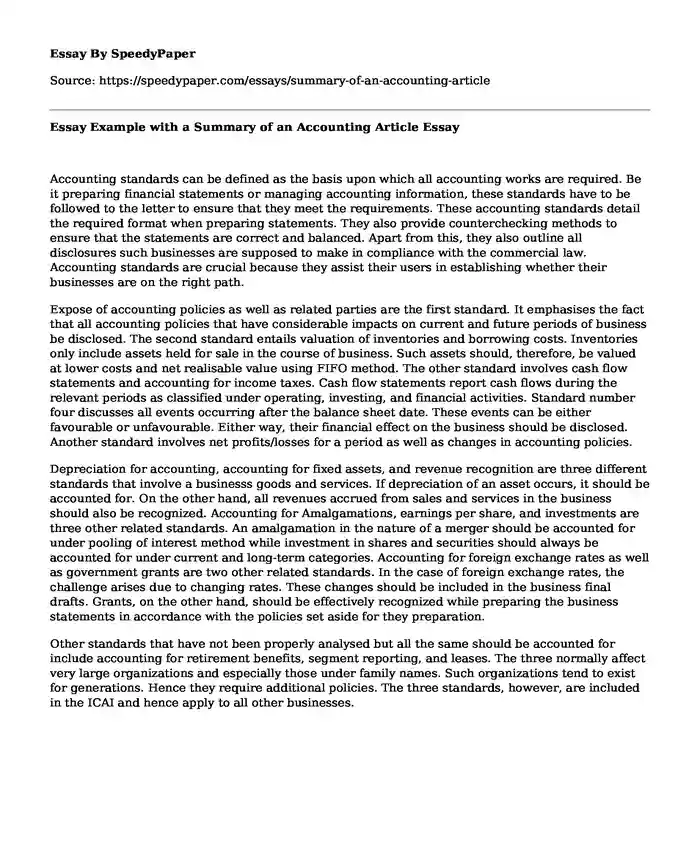
| Type of paper: | Essay |
| Categories: | Accounting |
| Pages: | 2 |
| Wordcount: | 477 words |
Accounting standards can be defined as the basis upon which all accounting works are required. Be it preparing financial statements or managing accounting information, these standards have to be followed to the letter to ensure that they meet the requirements. These accounting standards detail the required format when preparing statements. They also provide counterchecking methods to ensure that the statements are correct and balanced. Apart from this, they also outline all disclosures such businesses are supposed to make in compliance with the commercial law. Accounting standards are crucial because they assist their users in establishing whether their businesses are on the right path.
Expose of accounting policies as well as related parties are the first standard. It emphasises the fact that all accounting policies that have considerable impacts on current and future periods of business be disclosed. The second standard entails valuation of inventories and borrowing costs. Inventories only include assets held for sale in the course of business. Such assets should, therefore, be valued at lower costs and net realisable value using FIFO method. The other standard involves cash flow statements and accounting for income taxes. Cash flow statements report cash flows during the relevant periods as classified under operating, investing, and financial activities. Standard number four discusses all events occurring after the balance sheet date. These events can be either favourable or unfavourable. Either way, their financial effect on the business should be disclosed. Another standard involves net profits/losses for a period as well as changes in accounting policies.
Depreciation for accounting, accounting for fixed assets, and revenue recognition are three different standards that involve a businesss goods and services. If depreciation of an asset occurs, it should be accounted for. On the other hand, all revenues accrued from sales and services in the business should also be recognized. Accounting for Amalgamations, earnings per share, and investments are three other related standards. An amalgamation in the nature of a merger should be accounted for under pooling of interest method while investment in shares and securities should always be accounted for under current and long-term categories. Accounting for foreign exchange rates as well as government grants are two other related standards. In the case of foreign exchange rates, the challenge arises due to changing rates. These changes should be included in the business final drafts. Grants, on the other hand, should be effectively recognized while preparing the business statements in accordance with the policies set aside for they preparation.
Other standards that have not been properly analysed but all the same should be accounted for include accounting for retirement benefits, segment reporting, and leases. The three normally affect very large organizations and especially those under family names. Such organizations tend to exist for generations. Hence they require additional policies. The three standards, however, are included in the ICAI and hence apply to all other businesses.
Cite this page
Essay Example with a Summary of an Accounting Article. (2019, Jun 21). Retrieved from https://speedypaper.net/essays/summary-of-an-accounting-article
Request Removal
If you are the original author of this essay and no longer wish to have it published on the SpeedyPaper website, please click below to request its removal:
- Free Essay with Tricks for Getting Inspired to Write
- Free Essay on the Effects of Technology on Human Communication Skills among College Students
- Problems of Four-Day School Week, Free Essay in Education
- Free Essay Comprising a Social Media Campaign for Adidas Company
- Free Essay Example: Future and Market
- The Relationship Between the Government and the Media, Essay Example
- Essay Sample on Ethics of Abortion
Popular categories




